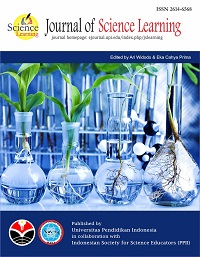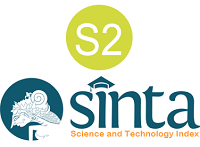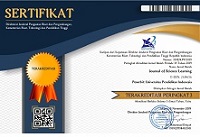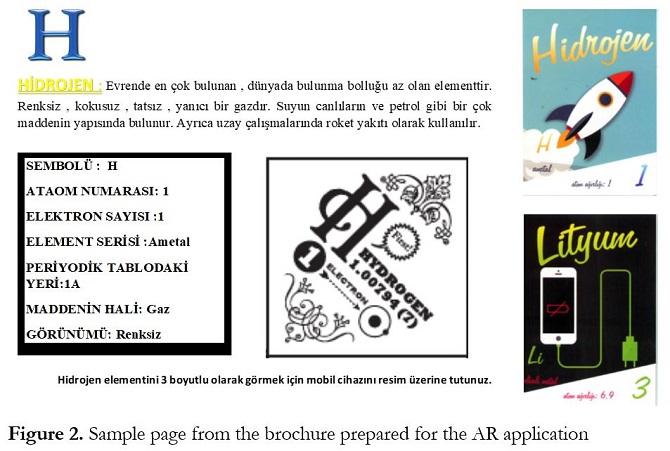
The Effects of Augmented Reality in a 7th-Grade Science Lesson on Students' Academic Achievement and Motivation
Abstract
This study examines the effects of a seventh-grade science course supported by augmented reality technologies on students' academic achievement on elements and compounds, their motivation towards the science course, and their motivation toward the augmented reality materials used. The study was conducted with the quasi-experimental design of the quantitative research method. The research sample consists of 50 seventh-grade students, 25 in the experimental group and 25 in the control group, studying in a public school. As data collection tools, academic achievement tests, motivation scale for learning science, and motivation scale for the materials used were utilized. In addition, the collected data were analyzed with the SPSS 24.0 program. As a consequence of the research, it was discovered that augmented reality technologies boosted students' academic success and motivation toward science learning (p<0.001). In addition, students' motivation toward augmented reality materials was also found to be high.
Full Text:
Download PDFReferences
Abdüsselam, M. S. & Karal, H. (2012). The effect of mıxed realıty envıronments on the students’ academıc Achıevement ın physıcs educatıon: 11th grade magnetısm topıc example. Journal of Research in Education and Teaching, 1(4), 170–181.
Ardito, C., Buono, P., Costabile, M. F., Lanzilotti, R., & Piccinno, A. (2009). Enabling interactive exploration of cultural heritage: an experience of designing systems for mobile devices. Knowledge, Technology & Policy, 22(1), 79-86.
Ateş, A., (2018), 7 th grade science and technology course "Structure of the substance and pure substances" on augmented reality created using technology learning material effect on academic achievement (Unpublished master’s thesis). Niğde Ömer Halisdemir Üniversitesi, Niğde
Azuma, R. T. (1997). A survey of augmented reality. Presence: teleoperators & virtual environments, 6(4), 355-385.
Bilgiç, H. G., Duman, D., & Seferoğlu, S. S. (2011). Dijital yerlilerin özellikleri ve çevrim içi ortamların tasarlanmasındaki etkileri [Characteristics of digital natives and their impact on designing online environments]. Akademik Bilişim, 2(4), 1-7.
Cai, S., Liu, E., Shen, Y., Liu, C., Li, S., & Shen, Y. (2020). Probability learning in mathematics using augmented reality: impact on student’s learning gains and attitudes. Interactive Learning Environments, 28(5), 560-573.
Cai, S., Wang, X., & Chiang, F. K. (2014). A case study of Augmented Reality simulation system application in a chemistry course. Computers in human behavior, 37, 31-40.
Chai, C., Mustafa, K., Kuppusamy, S., Yusof, A., Lim, C. S., & Wai, S. H. (2019). BIM integration in augmented reality model. Civil Engineering, 10(7).
Chang, Y. H., & Liu, J. (2013). Applying an ar technique to enhance situated heritage learning in a ubiquitous learning environment. The Turkish Online Journal of Educational Technology, 12(3), 21-32.
Chen, C. P., & Wang, C. H. (2015). Employing augmented-reality-embedded instruction to disperse the imparities of individual differences in earth science learning. Journal of Science Education and Technology, 24(6), 835-847.
Chin, K. Y., Wang, C. S., & Chen, Y. L. (2019). Effects of an augmented reality-based mobile system on students’ learning achievements and motivation for a liberal arts course. Interactive Learning Environments, 27(7), 927-941.
Cuban, L., Kirkpatrick, H., & Peck, C. (2001). High access and low use of technologies in high school classrooms: Explaining an apparent paradox. American Educational Research Journal, 38(4), 813-834.
Çakır, R., Solak, E., & Tan, S. S. (2015) “Artırılmış gerçeklik teknolojisi ile İngilizce kelime öğretiminin öğrenci performansına etkisi” [“The effect of teaching English vocabulary with augmented reality technology on student performance”]. Gazi Eğitim Bilimleri Dergisi, 1(1), 45-58.
Çakır, R., & Yıldırım, S. (2009). Bilgisayar öğretmenleri okullardaki teknoloji entegrasyonu hakkında ne düşünürler? [What do computer teachers think about technology integration in schools?]. İlköğretim Online, 8(3), 952-964.
Çankaya, S. (2019). Use of VR Headsets in Education: A Systematic Review Study. Journal of Educational Technology and Online Learning, 2(1), 74-88.
Dede Y., & Yaman S. (2008). Fen öğrenmeye yönelik motivasyon ölçeği: Geçerlik ve güvenirlik çalışması [Motivation scale for learning science: Validity and reliability study]. Necatibey Eğitim Fakültesi Elektronik Fen ve Matematik Eğitimi Dergisi, 2(1), 19-37.
Dilmen, I., & Atalay, N. (2021). The Effect of the Augmented Reality Applications in Science Class on Students' 21st Century Skills and Basic Skills. Journal of Science Learning, 4(4), 337-346.
Di Serio, Á, Ibáñez, M. B., & Kloos, C. D. (2013). Impact of an augmented reality system on students’ motivation for a visual art course. Computers & Education, 68, 586–596.
Dunleavy, M., Dede, C., & Mitchell, R. (2009). Affordances and limitations of immersive participatory augmented reality simulations for teaching and learning. Journal of Science Education and Technology, 18(1), 7-22.
Durak, A., & Karaoğlan Yılmaz, F. G. (2019). Opinions of secondary school students on educational practices of augmented reality. Bolu Abant İzzet Baysal University Journal of Education Faculty, 19(2), 468-481.
Dünser, A., Walker, L., Horner, H., & Bentall, D. (2012). Creating interactive physics education books with augmented reality. In Proceedings of the 24th Australian computer-human interaction conference (pp. 107-114).
Ekiçi, M., & Yeşilbursa, C. C. (2021). Artırılmış Gerçekliğin Sosyal Bilgiler Dersinde Kullanımı Hakkında Ortaokul Öğrencilerinin Görüşleri [Opinions of Secondary School Students on the Use of Augmented Reality in Social Studies Lessons]. Anemon Muş Alparslan Üniversitesi Sosyal Bilimler Dergisi, 9(2), 289-302.
Erbaş, C., & Demirer, V. (2019). The effects of augmented reality on students' academic achievement and motivation in a biology course. Journal of Computer Assisted Learning, 35(3), 450-458.
Ersoy, H., Duman, E., & Öncü, S. (2016). Artırılmış gerçeklik ile motivasyon ve başarı: deneysel bir çalışma [Motivation and success with augmented reality: an experimental study]. Journal of Instructional Technologies and Teacher Education, 5(1), 39-44.
Fleck, S., Hachet, M., & Bastien, J. C. (2015). Marker-based augmented reality: Instructional-design to improve children interactions with astronomical concepts. In Proceedings of the 14th International Conference on Interaction Design and Children (pp. 21-28).
Fleck, S., & Simon, G. (2013). An augmented reality environment for astronomy learning in elementary grades: An exploratory study. In Proceedings of the 25th Conference on l'Interaction Homme-Machine (pp. 14-22).
Fraenkel, J. R., Wallen, N. E., & Hyun, H. H. (2012). How to design and evaluate research in education (Vol. 7, p. 429). New York: McGraw-hill.
Guntur, M. I. S., Setyaningrum, W., Retnawati, H., & Marsigit, M. (2020). Assessing the potential of augmented reality in education. In Proceedings of the 2020 11th International Conference on E-Education, E-Business, E-Management, and E-Learning (pp. 93-97).
Güngördü, D. (2018). Artırılmış gerçeklik uygulamalarının ortaokul öğrencilerinin atom modelleri konusuna yönelik başarı ve tutumlarına etkisi [The effect of augmented reality applications on secondary school students' achievement and attitudes towards atomic models] (Unpublished master’s thesis). Kilis 7 Aralık Üniversitesi, Kilis.
Huang, T. C., Chen, C. C., & Chou, Y. W. (2016). Animating eco-education: To see, feel, and discover in an augmented reality-based experiential learning environment. Computers & Education, 96, 72-82.
Ibáñez, M. B., Di-Serio, Á., Villarán-Molina, D., & Delgado-Kloos, C. (2014). Augmented reality-based simulators as discovery learning tools: An empirical study. IEEE Transactions on Education, 58(3), 208-213.
Kalemkuş, J., & Kalemkuş, F. (2022). Effect of the use of augmented reality applications on academic achievement of student in science education: meta-analysis review. Interactive Learning Environments, 1-18.
Kaufmann, H., & Schmalstieg, D. (2003). Mathematics and geometry education with collaborative augmented reality. Computers & Graphics, 27(3), 339-345.
Keçeci, G., Yildirim, P., & Zengin, F. K. (2021). Opinions of Secondary School Students on the Use of Mobile Augmented Reality Technology in Science Teaching. Journal of Science Learning, 4(4), 327-336.
Kerawalla, L., Luckin, R., Seljeflot, S., & Woolard, A. (2006). “Making it real”: exploring the potential of augmented reality for teaching primary school science. Virtual reality, 10(3), 163-174.
Khan, T., Johnston, K., & Ophoff, J. (2019). The impact of an augmented reality application on learning motivation of students. Advances in Human-Computer Interaction, 2019.
Kıncal, Y., & Yazgan-Akan, D. (2010). İlköğretim 7. ve 8. sınıf öğrencilerinin formal operasyonel düşünme becerilerinin bazı değişkenler açısından incelenmesi [Investigation of formal operational thinking skills of 7th and 8th grade primary school students in terms of some variables]. İlköğretim Online, 9(2), 723-733.
Kızılca, G. (2019). Ortaokul 3. sınıf öğrencilerinin fen bilimleri dersi maddenin yapısı ve özellikleri ünitesinde mobil artırılmış gerçeklik uygulamalarının, fene yönelik tutumlarına ve akademik başarılarına etkisi [The effect of mobile augmented reality applications in the unit of the structure and properties of matter in the science lesson of middle school 3rd grade students on their attitudes towards science and academic achievement] (Unpublished master’s thesis). Muğla Sıtkı Koçman Üniversitesi.
Kutu, H., & Sözbilir, M. (2011). Öğretim materyalleri motivasyon anketinin Türkçeye uyarlanması: Güvenirlik ve geçerlik çalışması [Adaptation of Instructional Materials Motivation Survey to Turkish: A Validity and Reliability Study]. Necatibey Eğitim Fakültesi Elektronik Fen ve Matematik Eğitimi Dergisi, 5(1).
Küçük S., Yılmaz R. M., Baydaş Ö., & Göktaş Y. (2014). Augmented Reality Applications Attitude Scale in Secondary Schools: Validity and Reliability Study. Education and Science, 39(176), 383-392.
Lai, Y. S., & Hsu, J. M. (2011). Development trend analysis of augmented reality system in educational applications. In 2011 International Conference on Electrical and Control Engineering (pp. 6527-6531). IEEE.
Luckin, R., & Fraser, D. S. (2011). Limitless or pointless? An evaluation of augmented reality technology in the school and home. International Journal of Technology Enhanced Learning, 3(5), 510-524.
Matcha, W., & Rambli, D. R. A. (2013). Exploratory study on collaborative interaction through the use of augmented reality in science learning. Procedia computer science, 25, 144-153.
MEB. (2019). Retrieved from https://sgb.meb.gov.tr/
Midak, L. Y., Kravets, I. V., Kuzyshyn, O. V., Baziuk, L. V., & Buzhdyhan, K. V. (2021). Specifics of using image visualization within education of the upcoming chemistry teachers with augmented reality technology. In Journal of Physics: Conference Series (Vol. 1840, No. 1, p. 012013). IOP Publishing.
Milgram, P., & Kishino, F. (1994). A taxonomy of mixed reality visual displays. IEICE TRANSACTIONS on Information and Systems, 77(12), 1321-1329.
Mystakidis, S., Christopoulos, A., & Pellas, N. (2021). A systematic mapping review of augmented reality applications to support STEM learning in higher education. Education and Information Technologies, 1-45.
Núñez, M., Quirós, R., Núñez, I., Carda, J. B., Camahort, E., & Mauri, J. L. (2008). Collaborative augmented reality for inorganic chemistry education. In WSEAS international conference. Proceedings. Mathematics and computers in science and engineering (Vol. 5, pp. 271-277). WSEAS.
Omurtak, E. & Zeybek, G. (2022). The effect of augmented reality applications in biology lesson on academic achievement and motivation. Journal of Education in Science, Environment and Health (JESEH), 8(1), 55-74. https://doi.org/10.21891/jeseh.1059283
Osadchyi, V. V., Valko, N. V., & Kuzmich, L. V. (2021). Using augmented reality technologies for STEM education organization. In Journal of Physics: Conference Series (Vol. 1840, No. 1, p. 012027). IOP Publishing.
Övez, F. D., & Şeker, B. S. (2022). İlköğretimde artırılmış gerçeklik destekli disiplinler arası bir öğretim uygulaması [An augmented reality supported interdisciplinary teaching application in primary education]. Balıkesir Üniversitesi Fen Bilimleri Enstitüsü Dergisi, 24(1), 313-334.
Özarslan, Y. (2013). Genişletilmiş gerçeklik ile zenginleştirilmiş öğrenme materyallerinin öğrenen başarısı ve memnuniyeti üzerindeki etkisi [The effect of augmented reality enhanced learning materials on learners’ achievement and learners’ satisfaction]. (Unpublished doctoral thesis). Anadolu Üniversitesi, Eskişehir.
Pallant, J. (2020). SPSS Kullanma Klavuzu [SPSS User Manual], (Balcı, S. & Ahi B., Trans.). 3. Print, Ankara: Anı Publishing.
Peder Alagöz, Z. B. (2020). The effects of the mobile augmented reality applications on secondary school 7th grade students' anxiety towards science and academic achievements (Unpublished master’s thesis). Ankara: Gazi Üniversitesi Eğitim Bilimleri Enstitüsü.
Perez-Lopez, D. & Contero, M. (2013). Delivering educational multimedia contents through an augmented reality application: A case study on its impact on knowledge acquisition and retention. Turkish Online Journal of Educational Technology - TOJET, 12(4), 19–28.
Pozharina, G. (2019). The effects of using mobile augmented reality integrated materials on students’ motivation and attitude level in EFL academic writing classes (Unpublished master’s thesis). İstanbul Aydın Üniversitesi Sosyal Bilimler Enstitüsü.
Ramazanoğlu, M., & Solak, M. Ş. (2020). Ortaokul öğrencilerinin artırılmış gerçeklik uygulamalarının eğitimde kullanımına yönelik tutumları: Siirt İli Örneği [Attitudes of secondary school students towards the use of augmented reality applications in education: Siirt Province Example]. Kastamonu Eğitim Dergisi, 28(4), 1646-1656.
Radu, I. (2012). Why should my students use AR? A comparative review of the educational impacts of augmented-reality. In 2012 IEEE International Symposium on Mixed and Augmented Reality (ISMAR) (pp. 313-314). IEEE.
Rambli, D. R. A., Matcha, W., & Sulaiman, S. (2013). Fun learning with AR alphabet book for pre-school children. Procedia Computer Science, 25, 211–219.
Roopa, D., Prabha, R., & Senthil, G. A. (2021). Revolutionizing education system with interactive augmented reality for quality education. Materials Today: Proceedings, 46, 3860-3863.
Shelton, B. E., & Hedley, N. R. (2002). Using augmented reality for teaching earth-sun relationships to undergraduate geography students. In The First IEEE International Workshop Agumented Reality Toolkit, (pp. 8-pp). IEEE.
Sırakaya, M., & Sırakaya, D. A. (2018). The Effect of Augmented Reality Use in Science Education on Attitude and Motivation. Kastamonu Eğitim Dergisi, 26(3), 887-905.
Sin, A. K., & Zaman, H. B. (2010). Live Solar System (LSS): Evaluation of an Augmented Reality book-based educational tool. In 2010 International Symposium on Information Technology (Vol. 1, pp. 1-6). IEEE.
Somyürek, S. (2014). Attracting the attention of generation Z in the teaching process: Augmented reality. Educational Technology Theory and Practice, 4(1), 63-80. https://doi.org/10.17943/etku.88319
Squire, K., & Klopfer, E. (2007). Augmented reality simulations on handheld computers. Journal of the Learning Sciences, 16(3), 371- 413.
Sumadio, D. D., & Rambli, D. R. A. (2010). Preliminary evaluation on user acceptance of the augmented reality use for education. Proceedings of Second International Conference on Computer Engineering and Applications (pp. 461-465).
Sural, I. (2018). Augmented Reality Experience: Initial Perceptions of Higher Education Students. International Journal of Instruction, 11(4), 565-576.
Şahin, N., & Güler, B. (2021). Astronomi Öğrenme Ortamlarını Zenginleştirmeye Yönelik Bir Uygulama: Star Walk 2 [An App To Enrich Astronomy Learning Environments: Star Walk 2]. Öğretim Teknolojisi ve Hayat Boyu Öğrenme Dergisi, 2(2), 248-284.
Tabachnick, B. G., & Fidell, L. S. (2013). Çok değişkenli istatistiklerin kullanımı [Use of multivariate statistics] (M. Baloğlu, Trans.). Ankara: Nobel Academy.
Tanik Önal, N., & Önal, N. (2021). The effect of augmented reality on the astronomy achievement and interest level of gifted students. Education and Information Technologies, 26, 4573-4599.
Tomi, A. B., & Rambli, D. R. A. (2013). An interactive mobile augmented reality magical playbook: Learning number with the thirsty crow. Procedia computer science, 25, 123-130.
Van Krevelen, D. W. F., & Poelman, R. (2010). A survey of augmented reality technologies, applications and limitations. International journal of virtual reality, 9(2), 1-20.
Wojciechowski, R., & Cellary, W. (2013). Evaluation of learners’ attitude toward learning in ARIES augmented reality environments. Computers & education, 68, 570-585.
Yaşar, Ş. (1998). Yapısalcı Kuram ve Öğretme-Öğrenme Süreci [Structural Theory and Teaching-Learning Process]. Anadolu Üniversitesi Eğitim Fakültesi Dergisi, 8(1-2), 68-75.
Yetişir, H. (2019). Mobil cihazlarla artırılmış gerçeklik uygulamalarının öğrencilerin akademik başarı, tutum ve kalıcılığına etkisi [The effect of augmented reality applications with mobile devices on students' academic achievement, attitude and persistence] (Master's thesis, Eğitim Bilimleri Enstitüsü).
Yusoff, Z., & Dahlan, H. M. (2013). Mobile based learning: An integrated framework to support learning engagement through Augmented Reality environment. In 2013 International Conference on Research and Innovation in Information Systems (ICRIIS) (pp. 251-256). IEEE.
DOI: https://doi.org/10.17509/jsl.v5i2.42952
Refbacks
- There are currently no refbacks.
Copyright (c) 2022 Hasan Hüseyin Kul, Asiye Berber

This work is licensed under a Creative Commons Attribution-ShareAlike 4.0 International License.
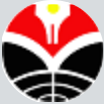

Jl. Dr. Setiabudhi 229 Bandung 40154, West Java, Indonesia






